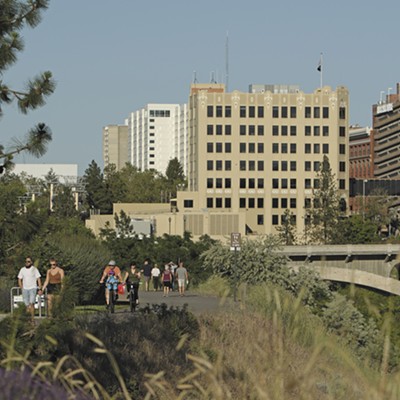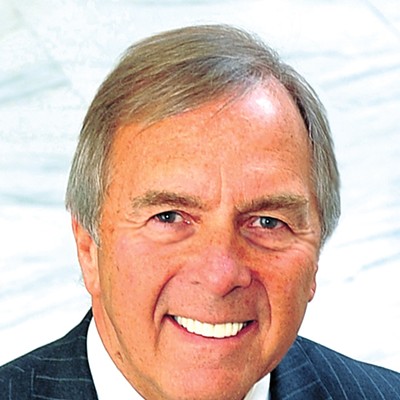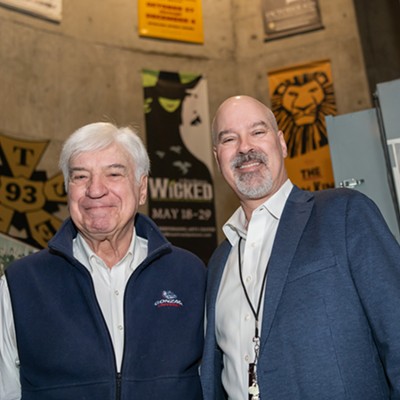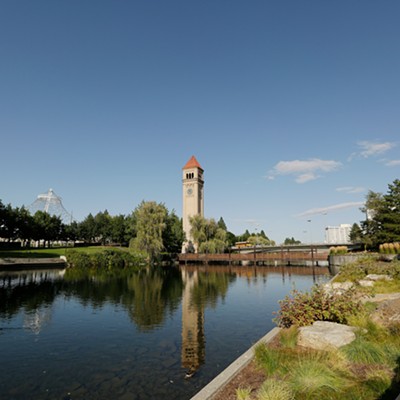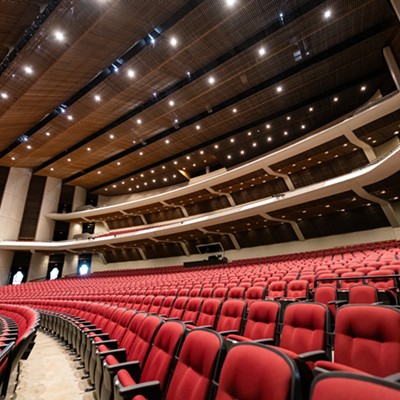A Cutting Edge Facility
[
{
"name": "Broadstreet - Instory",
"component": "25846487",
"insertPoint": "4",
"requiredCountToDisplay": "4"
},{
"name": "Broadstreet - Empower Local",
"component": "27852456",
"insertPoint": "8",
"requiredCountToDisplay": "8"
},{
"name": "Broadstreet - Instory",
"component": "25846487",
"insertPoint": "12",
"requiredCountToDisplay": "12"
},{
"name": "Broadstreet - Instory - 728x90 / 970x250",
"component": "27852677",
"insertPoint": "18",
"requiredCountToDisplay": "18"
},{
"name": "Broadstreet - Instory",
"component": "25846487",
"insertPoint": "5th",
"startingPoint": "23",
"requiredCountToDisplay": "24",
"maxInsertions": 100
}
]
by Ted S. McGregor Jr.
Remember when they imploded the Kingdome? For many, it was just plain cool, but for those who design and build public facilities, it had to be a chilling moment. How could they design something that could become so outdated in just a couple of decades?
There are some concerns that, as with sports, the convention business is changing all the time, making the threat of building something that's soon to be obsolete all too real. Complicating this is the fact that 9/11 really did change the convention business. It's too soon to know if those changes are permanent, but they will affect Spokane's convention center.
"The change has been that the mega-groups are subdividing and focusing on regional gatherings," says John Brewer, president of the Spokane Regional Convention and Visitors Bureau, the organization that markets and sells the convention center to meeting planners.
This could play to Spokane's strength as a regional player. And the one constant in the post-9/11 paradigm has been that the statewide and regional meetings, which people can drive to, have remained steady.
"People aren't planning out as far since 9/11," adds Jerry Baron, manager of the soon-to-open Palm Beach, Fla., convention center. "And it's smaller stuff, booking six to 10 months out, and sizes are down, too."
And while not directly related to
9/11, the weak national economy has led to fewer meetings and to meeting planners trying to stretch their dollars. Again, this could play to Spokane's advantage, as its hotel taxes and room rates are lower than many of the city's competitors.
But 9/11 has led to increased costs, too, especially in the area of security.
"Managers are asking to tighten up security for underground parking," says Don Grinberg, director of convention center architecture for HNTB of Boston. "In new buildings, they're thinking about blast-resistant glass, berms to keep vehicles away. These places are rated as vulnerable targets."
Most agree that adding a large exhibition hall of at least 100,000 square feet is a good move for Spokane. This new facility would allow for the reconfiguration of the existing convention center into a larger ballroom and more meeting rooms. All these moves fit current trends.
"You want to have a ballroom bigger than anything else in the city," says Grinberg. "Make it the biggest."
Baron says his facility will have a 25,000-square-foot ballroom -- the largest in the county.
More small meeting rooms have come into demand as well. "A lot of the groups are wanting niche meeting spaces, for 50 to 100 people," says Brewer.
Technology has also become important: "You need robust fiber-optic all over, and the capacity to record sessions," says Grinberg, who adds that since technology changes all the time, leaving lots of open conduit in the walls has become standard for new convention centers.
And the exhibition halls have become places with high-tech needs, too, as exhibits grow more sophisticated. Baron says a good rule of thumb is to have "floor boxes" every 30 feet, with water, air, power, phone, data and other utilities.
Surprisingly enough, one of the areas that has changed the most over the years isn't high-tech at all -- it's food.
"No more rubber chicken," says Grinberg with a laugh. "I guess the West Coast has influenced habits, because there is a higher emphasis on quality. So we're designing bigger kitchens, better thought-out kitchens."
The higher standards don't come for free, however: Food service has become any convention center's second largest source of revenue.
One of the other ways the convention business has changed is in how it is managed and marketed. In Palm Beach, for example, Baron works for Global Spectrum, a Philadelphia company that manages stadiums and convention centers for cities or public facilities districts across the nation. They don't like the word "privatization," but that's essentially what it is: public services delivered by a private firm under contract -- kind of like garbage service in Spokane County.
In its study of the convention center expansion, the PFD decided to handle the management -- perhaps 30 total employees -- while contracting out the remainder, as it does at the Arena.
"Every firm charges a healthy service fee," says Kevin Twohig, executive director of the Public Facilities District, "and that money leaves Spokane. Our board went through an exploration of every management alternative."
As for the marketing, it's handled here by the CVB, which is funded, in part, by the city and the county.
The newest PFD Board member, Erik Skaggs, who was appointed by Spokane County, plans to press the CVB. "I'm concerned about building something that's not properly marketed. We seem to be waiting for the PFD to build a big box and they will come. Constituencies need to get serious, and they better start showing a level of innovative thinking."
Brewer says the CVB answers directly to its board of 17, and its public funding must be voted on by elected officials every year.
Baron says there are very strong facilities operated and marketed locally, but he adds that large firms like his and SMG have lots of connections individual CVB's may not be able to exploit. Twohig argues, however, that a national firm would view Spokane as one of many centers to sell, while the local CVB is only selling Spokane.
As for designing a cutting-edge facility that won't need to be imploded any time soon, that falls to the Integrus architecture firm of Spokane. To gain expertise in convention centers, it has hired LMN of Seattle for assistance.
"What we can do is budget-driven," says George Nachtsheim, principal architect at Integrus, who will be working with Rick Berg on the project to build the new hall and renovate the existing space. "This is a complex project, with a tough schedule, but the whole place is going to feel brand-new."
Grinberg says the best start to any project he has worked on is touring the competition. That way, you can find out if there are any shortcomings your facility can exploit. All that feeds into the design, and later the marketing.
Brewer says Spokane's biggest competition comes from Seattle, Portland, Albuquerque, San Diego and Denver. "We're really in the big leagues when it comes to who we are competing with," he says.
"Differentiating what you do in the design of these buildings is critical," says Grinberg. "These are the only buildings [a city] will build to compete with other cities."
Publication date: 05/29/03
Remember when they imploded the Kingdome? For many, it was just plain cool, but for those who design and build public facilities, it had to be a chilling moment. How could they design something that could become so outdated in just a couple of decades?
There are some concerns that, as with sports, the convention business is changing all the time, making the threat of building something that's soon to be obsolete all too real. Complicating this is the fact that 9/11 really did change the convention business. It's too soon to know if those changes are permanent, but they will affect Spokane's convention center.
"The change has been that the mega-groups are subdividing and focusing on regional gatherings," says John Brewer, president of the Spokane Regional Convention and Visitors Bureau, the organization that markets and sells the convention center to meeting planners.
This could play to Spokane's strength as a regional player. And the one constant in the post-9/11 paradigm has been that the statewide and regional meetings, which people can drive to, have remained steady.
"People aren't planning out as far since 9/11," adds Jerry Baron, manager of the soon-to-open Palm Beach, Fla., convention center. "And it's smaller stuff, booking six to 10 months out, and sizes are down, too."
And while not directly related to
9/11, the weak national economy has led to fewer meetings and to meeting planners trying to stretch their dollars. Again, this could play to Spokane's advantage, as its hotel taxes and room rates are lower than many of the city's competitors.
But 9/11 has led to increased costs, too, especially in the area of security.
"Managers are asking to tighten up security for underground parking," says Don Grinberg, director of convention center architecture for HNTB of Boston. "In new buildings, they're thinking about blast-resistant glass, berms to keep vehicles away. These places are rated as vulnerable targets."
Most agree that adding a large exhibition hall of at least 100,000 square feet is a good move for Spokane. This new facility would allow for the reconfiguration of the existing convention center into a larger ballroom and more meeting rooms. All these moves fit current trends.
"You want to have a ballroom bigger than anything else in the city," says Grinberg. "Make it the biggest."
Baron says his facility will have a 25,000-square-foot ballroom -- the largest in the county.
More small meeting rooms have come into demand as well. "A lot of the groups are wanting niche meeting spaces, for 50 to 100 people," says Brewer.
Technology has also become important: "You need robust fiber-optic all over, and the capacity to record sessions," says Grinberg, who adds that since technology changes all the time, leaving lots of open conduit in the walls has become standard for new convention centers.
And the exhibition halls have become places with high-tech needs, too, as exhibits grow more sophisticated. Baron says a good rule of thumb is to have "floor boxes" every 30 feet, with water, air, power, phone, data and other utilities.
Surprisingly enough, one of the areas that has changed the most over the years isn't high-tech at all -- it's food.
"No more rubber chicken," says Grinberg with a laugh. "I guess the West Coast has influenced habits, because there is a higher emphasis on quality. So we're designing bigger kitchens, better thought-out kitchens."
The higher standards don't come for free, however: Food service has become any convention center's second largest source of revenue.
One of the other ways the convention business has changed is in how it is managed and marketed. In Palm Beach, for example, Baron works for Global Spectrum, a Philadelphia company that manages stadiums and convention centers for cities or public facilities districts across the nation. They don't like the word "privatization," but that's essentially what it is: public services delivered by a private firm under contract -- kind of like garbage service in Spokane County.
In its study of the convention center expansion, the PFD decided to handle the management -- perhaps 30 total employees -- while contracting out the remainder, as it does at the Arena.
"Every firm charges a healthy service fee," says Kevin Twohig, executive director of the Public Facilities District, "and that money leaves Spokane. Our board went through an exploration of every management alternative."
As for the marketing, it's handled here by the CVB, which is funded, in part, by the city and the county.
The newest PFD Board member, Erik Skaggs, who was appointed by Spokane County, plans to press the CVB. "I'm concerned about building something that's not properly marketed. We seem to be waiting for the PFD to build a big box and they will come. Constituencies need to get serious, and they better start showing a level of innovative thinking."
Brewer says the CVB answers directly to its board of 17, and its public funding must be voted on by elected officials every year.
Baron says there are very strong facilities operated and marketed locally, but he adds that large firms like his and SMG have lots of connections individual CVB's may not be able to exploit. Twohig argues, however, that a national firm would view Spokane as one of many centers to sell, while the local CVB is only selling Spokane.
As for designing a cutting-edge facility that won't need to be imploded any time soon, that falls to the Integrus architecture firm of Spokane. To gain expertise in convention centers, it has hired LMN of Seattle for assistance.
"What we can do is budget-driven," says George Nachtsheim, principal architect at Integrus, who will be working with Rick Berg on the project to build the new hall and renovate the existing space. "This is a complex project, with a tough schedule, but the whole place is going to feel brand-new."
Grinberg says the best start to any project he has worked on is touring the competition. That way, you can find out if there are any shortcomings your facility can exploit. All that feeds into the design, and later the marketing.
Brewer says Spokane's biggest competition comes from Seattle, Portland, Albuquerque, San Diego and Denver. "We're really in the big leagues when it comes to who we are competing with," he says.
"Differentiating what you do in the design of these buildings is critical," says Grinberg. "These are the only buildings [a city] will build to compete with other cities."
Publication date: 05/29/03




